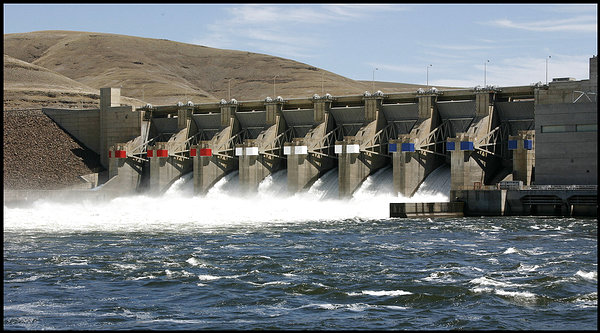forum
library
tutorial
contact

To Help Salmon Migrate, State
Looks to Spill More Over Dams
by Simone Del Rosario
Q13 Fox, February 19, 2019
|
the film forum library tutorial contact |

|
To Help Salmon Migrate, State
by Simone Del Rosario
|
"At a time when the governor asked us to be bold and when the governor puts
a $1.2 billion budget out for orca, we really wanted to see more than a tweak,"
 VANCOUVER, Wash. -- While federal officials consider breaching one or more dams in Washington to increase salmon survival, state officials are considering increasing spill over the dams to help more smolts survive in the meantime.
VANCOUVER, Wash. -- While federal officials consider breaching one or more dams in Washington to increase salmon survival, state officials are considering increasing spill over the dams to help more smolts survive in the meantime.
If there is too little spill at hydrodams, more young, vulnerable salmon are sent down more dangerous turbines to get past them. If there is too much spill, they can die from the pressure, with gas bubbles suffocating their gills. It's similar to "the bends," a decompression illness that happens to scuba divers who come to the surface too fast.
At the direction of the governor’s orca task force, Washington is trying to strike a balance by increasing spill thresholds so more smolts can make it through.
"How much recovery value it has has always been the subject of debate, but pretty much everybody has agreed that more will help," said Michael Garrity, Columbia River and Water Policy Manager for Washington Department of Fish and Wildlife.
At a public hearing in Vancouver, Washington, the Department of Ecology heard testimony from people who wanted to weigh in on a measure to increase spill.
"This is one of the few things the state can do to provide more salmon for orcas in just a few years," said Sristi Kamal of Defenders of Wildlife. "The more fish that are spilled, the more fish that return to the river as adults to spawn."
The department is considering an increase on 'total dissolved gas,' or TDG, on the lower Columbia and Snake rivers from April to June. TDG measures spill around dams, relating it to normal river flows.
For example, a TDG reading of 110 percent means that there is 10 percent more pressure in the water than normal. While Washington has a statewide TDG cap of 110 percent, it's higher around the Columbia and Snake River dams to help fish passage.
While the governor’s orca task force mulls over effects of breaching dams on the lower Snake River for salmon survival, they recommended increasing spill over the dams up to 125 percent TDG. The increased spill would apply to eight federal dams, four on the lower Snake River and four on the lower Columbia.
The Department of Ecology, however, is recommending a more minor increase to 120 percent in front of the dams, called the forebay. The water after each dam, the tailrace, is already allowed to reach 120 percent.
"So 120, for sure we're comfortable with," said Heather Bartlett, program manager for Ecology's water quality program. "With 125, we would want to be able to evaluate the effects on other critters."
Some scientific models estimate spill up to 125 percent could help stabilize Chinook salmon populations, but critics worry about the effects on other fish that are not as capable of avoiding the pressure.
In addition, the state has signed on to a flexible spill agreement with operators of the hydrodams, allowing Bonneville Power and the U.S. Army Corps of Engineers to spill even less than that threshold for eight hours a day, when power is in high demand.
Some people testifying in Vancouver argued these measures don't go far enough.
"At a time when the governor asked us to be bold and when the governor puts a $1.2 billion budget out for orca, we really wanted to see more than a tweak," commented Liz Hamilton, executive director of Northwest Sportfishing Industry Association.
Consistent increased spill may help salmon populations reach minimum targets for recovery, something biologists have struggled to achieve for years. Still, it might not be enough.
"Additional spill is good, lower Snake River dam removal is another increment better," Garrity said.
While dam breaching continues to be debated in a National Environmental Policy Act process, increased spill is close to a decision.
The Department of Ecology is holding an online webinar and hearing Tuesday night for people to weigh in. The public has until February 28, 2019, to submit comment on the proposal.
learn more on topics covered in the film
see the video
read the script
learn the songs
discussion forum
